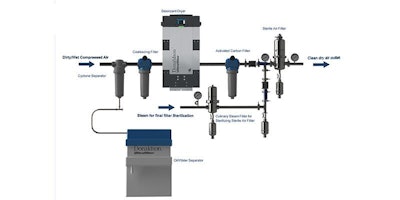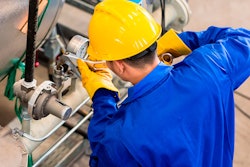
Every food and beverage manufacturing process uses air, which commonly has direct contact with the product or surfaces the product touches. Compressed air is used to texturize food, dry sterilized equipment, form bottles, move ingredients through lines and protect liquids in storage tanks. However, compressed air can introduce moisture into a finished product.
It’s critical then, to keep process air clean and sterile. If not removed, organisms within air can quickly multiply downstream, altering the taste — and potentially the safety — of your product.
The contaminant most prevalent in compressed air systems is not rust or dirt. It’s liquid, with water and oil both common moisture threats. All intake air has humidity, and most compressors operate with lubricants. Water and oil make an ideal organic diet for microorganisms, and the dark warm crevices in compressed air lines can provide a breeding space. Any oil/water biofilm that seeps downstream can also clog and degrade process piping — permanently.
Keeping air dry and oil-free, then, is a very important part of keeping it sterile. A series of filters after air is generated and cooled will help minimize the risk of water, oil, and bacteria migrating downstream into your product. Here are the stages in moisture control filtration:
Filtration Steps for Compressed Air
All compressed air systems will have a water problem starting in the compressor room, whether the inlet is plumbed to the outside or draws from a plant’s indoor air. The volume of humidity will simply vary with ambient air conditions, depending on seasonal weather or climate.
Refrigerated dryer
As intake air gets squeezed in the compressor, it heats up and needs to be cooled to a subtle temperature useful for processing. Compressor systems have an after-cooler for this purpose. The after-cooler also functions as a refrigerated dryer, chilling the air and removing bulk moisture produced during condensation — similar to air condensing on a cold glass of beer.
However, there is still significant liquid content in compressed air after it leaves a refrigerated dryer. It’s important to send the air — and any residual oil — through a sequence of treatments that will remove progressively smaller liquid particles. These filters are:
- A cyclone separator to remove bulk water in high volumes
- A coalescing filter to extract more difficult aerosol liquid
- An air dryer to eliminate remaining water vapor.
Each component should be carefully selected and sized for your source air humidity and processing requirements.
Cyclone separator
A cyclone separator is a housing without a filter element inside. It operates on principles of inertia, taking advantage of the density differences between air and water. Spinning at high velocity, liquid particles (heavier than air) fall out of the rotating path and hit a receptacle, where they’re drained away.
In choosing a cyclone separator, be aware that higher velocities produce higher separation efficiencies. It’s also important for optimal device functioning not to over-size the separator. Match the device’s design flow rate with the system flow rate, so it operates efficiently.
As important as the cyclone is in removing bulk water and courser contaminants, it’s only the first step. A coalescing filter afterwards is necessary to capture aerosols.
Coalescing Filter
Air flowing through the heat exchanger in a refrigerated dryer encounters pipes, fittings and elbows that will aerosolize any liquid in that air. Like fog, aerosols are hard to catch — and that’s the purpose of a coalescing filter.
A coalescing filter is designed to capture very tiny droplets of liquid and combine (coalesce) them into larger droplets that can be drained away. When choosing a coalescing filter, it’s important to know the removal efficiency you require, as well as filter media that will readily shed water. This shedding factor is important, because wet filters restrict airflow. You want your filter to remove water while still operating in as close to a dry state as possible.
The best coalescing filters will have a pleated media, a high flow rate and low pressure drop. Look for filters with hydrophobic and oleo-phobic pleated media that have been proven to perform according to ISO 12500 testing. These test results ensure that different manufacturers’ products can be compared directly. Pleated filters with a free fiber structure are typically better-performing than wrapped or resin-bonded medias, which have glues (resins) that take up space and block airflow. Filters with high flow rates and low pressure drop provide improved cost-savings, since less pressure and energy are needed to move air through the system.
A coalescing filter operates “inside out” compared with traditional particle filters that flow from the outside to the inside of the cartridge. Air comes into its center space, and flows outwards through the media — to avoid filling the element with water.
Be aware that a cyclone separator resembles a coalescing filter from the outside. If you’re “inheriting” supervision of an established food or beverage process line, inspect the compressed air filtering system carefully to make sure you have both devices.
Compressed Air Dryer
Your refrigerated dryer and cyclone separator will remove 80-90 percent of the liquids in your intake air, with the coalescing filter handling the rest. However, there’s one more step in drying air: vapor removal to inhibit the growth of bacteria downstream.
This step is necessary because the coalescing filter captures bacteria — and therefore can harbor contaminants within the element itself. These bacteria may not be hazardous in small concentrations, but they can become a threat downstream unless you eliminate the warm, moist conditions they need to multiply. As important as it is to capture contamination, it’s just as important to dry the air so bacteria cannot thrive in it.
A high-quality adsorption dryer performs this step. It works very differently from the condensation of refrigerated drying. In adsorption drying, liquid molecules stick (adsorb) to the desiccant material inside the dryer. These gaseous water molecules are collected and “swept” away using a small fraction of the very dry air produced in the dryer, called regeneration or “re-gen air.” Heatless adsorption dryers remove humidity from the airstream and regenerate themselves by switching between two desiccant “towers” approximately every four minutes.
From the performance of the adsorption dryer, you can also infer what’s happening at other points in your moisture-control efforts. If you detect a higher-pressure dew point than expected, for example, it might mean the dryer is overwhelmed by water that’s not being adequately removed by the cyclone separator and/or coalescing filter.
 A facility supervisor inspects a cyclone separator on a compressed air system, followed by two coalescing filters. A duplicate set of filters (near ceiling) allows one set to be off-line for cleaning and maintenance, while the process line still functions.
A facility supervisor inspects a cyclone separator on a compressed air system, followed by two coalescing filters. A duplicate set of filters (near ceiling) allows one set to be off-line for cleaning and maintenance, while the process line still functions.Design Considerations: Placement and Climate
All the moisture control steps discussed to this point are intended for compressed air at its point of generation — not on your food processing line. However, you should place the last two steps — coalescing filter and dryer — as close to your production line as possible.
When air is used directly for processing, place a fine-micron filter at each point of use — at entrance points for storage tank blanketing, for instance, or for product texturizing or package molding. This “last-chance” capture mechanism after the coalescing filter will provide an added level of drying to help decrease contaminants, such as metal flaking or corrosion, introduced by your system.
Also, take your weather into account. If you have seasonal swings in relative humidity, size your equipment to handle peak demands. For example, summer temperatures in Minnesota can be 100 degrees with high relative humidity and a 70-degree dew point, generating tons of water during air compression. But in the winter, the air is cold and dry. A system in this region needs to be designed for the worst-case scenario, with sufficient size to deal with a high volume of bulk water in the summer.
 Sample filtration system for converting moist inlet air into clean dry compressed air.
Sample filtration system for converting moist inlet air into clean dry compressed air.Architecture and the layout of your facility can also play an important part in air quality. If cooled air leaves your compressor room and goes outside through a pipe into another area, any outdoor temperature difference may produce additional condensation that you’ll need to remove again. Often, the goal isn’t necessarily to remove all of the gaseous water vapor entirely; it’s to keep the system from ever reaching the temperature that produces liquid condensation — its dew point. Be vigilant about any opportunities for freezing, which will damage your system and endanger your product.
It’s ideal to design and install all components of your moisture-control system at once, during a remodel or new plant construction. Each individual component is important to the efficient operation of the system as a whole. But improvements are always possible on existing lines. Just be sure to take moisture control steps before your facility has an issue. If you work with a filter manufacturer experienced in food and beverage process and moisture control, you’ll rest easier.























